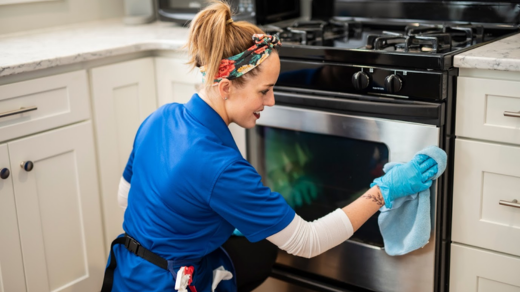Think surface clean is enough? Let’s talk about what’s lurking beneath the couch and in the air vents. When we talk about “regular cleaning,” most people mean dusting, vacuuming lightly, wiping surfaces. But deep cleaning goes further: it reaches areas you rarely touch—behind appliances, inside ventilation ducts, underneath baseboards, grout lines, behind furniture, inside upholstery, etc. Deep cleaning isn’t just about aesthetics. It helps remove built-up grime, allergens, hidden mold, and microscopic debris that conventional cleaning leaves behind.
This information was given from an interview with Happy Clean, offering expert stain removal services in Dublin.
Deep Cleaning Improve Indoor Air Quality
Hidden Allergens & Dust Mite Build-Up
Dust isn’t just “visible fluff.” It’s a mix of dead skin cells, dust mite fragments, pet dander, pollen, and microscopic particles. The American Lung Association notes that many homes carry dust mite allergen deep in bedding, carpets, and furniture, which aggravates allergies and asthma. Over time, this dust becomes airborne, recirculates through HVAC systems, and worsens indoor air quality. A deep cleaning that includes vacuuming with a HEPA filter, steam-cleaning carpets, wiping all surfaces with a damp cloth (to trap dust rather than just scatter it) helps significantly reduce that allergen load.
Ventilation, HVAC & Filter Care
Your heating, ventilation, and air conditioning (HVAC) system is the lung of your home. If vents, ducts, and filters are clogged with dust and debris, your system works harder, circulates stale air, and becomes a breeding ground for mold or bacteria. Deep cleaning means regularly cleaning or replacing filters, brushing vent covers, and (periodically) having ducts professionally cleaned. The EPA recommends keeping indoor spaces clean, dry, and ventilated to avoid odor or pest problems. Environmental Protection Agency Upgrading to good filters or adding air purifiers can also amplify the benefit, lowering airborne particles and thus supporting healthier indoor air.
Mold, Mildew & Moisture Control
Moist, humid areas such as bathrooms, basements, kitchens are susceptible to mold and mildew growth. These fungi release spores that aggravate allergies, respiratory issues, or even more serious health problems. Deep cleaning tackles these spots: scrubbing grout with mold-resistant cleaners, using mild bleach or antimicrobial sprays (where safe), drying surfaces thoroughly, ensuring ventilation (e.g. exhaust fans), and checking for hidden leaks. Over time, that vigilance prevents mold from taking hold and helps sustain clean air inside your home.
Regular Cleaning Extend the Life of Furniture, Floors & Appliances
Dirt Abrasion — How Grit Wears Surfaces
Every footstep brings in microscopic dirt, sand, and grit that slowly grinds down surfaces—especially hardwood, laminate, and tile floors. That same fine dust settles into furniture joints, baseboards, and corners, acting like invisible sandpaper. Over time, it dulls finishes, scratches surfaces, and reduces the life span of your flooring and furnishings. Deep cleaning—like mopping with the right floor cleaner, vacuuming under furniture, and polishing surfaces—removes those tiny abrasives before they can do damage. It’s not just about keeping things shiny; it’s about protecting your investment. Think of deep cleaning as preventive maintenance that preserves your home’s value and saves money on costly repairs or replacements later.
Protecting Upholstery, Rugs & Carpets
Carpets and upholstery are like magnets for dust, crumbs, and pet dander. Regular vacuuming helps, but only deep cleaning—using steam or hot water extraction—can truly remove the dirt and allergens trapped deep within the fibers. That’s why professional carpet cleaners often recommend doing it at least twice a year. Over time, those trapped particles can break down the fibers, fade colors, and even cause lingering odors. The same goes for upholstered furniture—vacuum crevices, spot-treat stains, and occasionally deep clean fabric with suitable solutions. A cleaner home not only looks better but feels fresher and lasts longer.
Appliance Efficiency & Maintenance
Your appliances work better and last longer when kept clean. Dust buildup behind your refrigerator or lint in your dryer vent forces the machine to work harder, consuming more energy and shortening its life. Deep cleaning includes pulling out large appliances to vacuum or wipe behind them, cleaning coils, descaling washing machines, and disinfecting microwaves and dishwashers. These small maintenance actions reduce wear, improve efficiency, and can even lower your energy bills. A clean appliance is a healthy one—just like the rest of your home.
4. Deep Cleaning Prevent Pest Infestations
Crumbs, Spills & Hiding Places
Pests like ants, cockroaches, and rodents thrive on what’s left behind after casual cleaning. Tiny crumbs under the toaster, grease behind the stove, or spilled juice under the fridge can become a buffet for unwanted guests. Deep cleaning removes these food sources completely—scrubbing under appliances, cleaning cabinets, and checking hidden corners. The cleaner your home, the less attractive it becomes to pests looking for food or nesting spots.
Moisture & Molds Attracting Pests
Moisture is another pest magnet. Standing water or dampness from leaky pipes or clogged drains attracts bugs like silverfish and cockroaches. Moldy spots can also draw in mites. During deep cleaning, inspecting and drying damp areas is crucial. Wipe down bathroom tiles, clean under sinks, and repair leaks quickly. Controlling moisture keeps pests and mold at bay while maintaining a fresher, healthier atmosphere indoors.
Early Warning Signs & Mitigation
Regular deep cleaning also acts as a home inspection—you’re more likely to notice signs of infestations early, like droppings, gnaw marks, or strange smells. Catching these clues before pests spread saves both money and frustration. Simple steps like sealing cracks, storing food properly, and cleaning pet areas thoroughly reduce risk dramatically. Prevention always beats extermination, and deep cleaning gives you that peace of mind.
5. Enhancing Family Health & Safety
Reducing Pathogens on High-Touch Surfaces
Door handles, light switches, remotes, and countertops can harbor bacteria and viruses for days. While surface cleaning wipes help, deep cleaning adds that extra layer of defense—sanitizing and disinfecting less obvious areas like behind handles, under sink rims, or around toilet bases. This helps reduce the spread of colds, flu, and other infections, especially in homes with kids or pets.
Minimizing Slips, Falls & Hidden Hazards
Clutter, dust buildup, and spills can all lead to accidents. Polishing floors, securing rugs, and keeping pathways clear during a deep clean reduces the risk of slips and falls—something particularly important for older family members. Even decluttering closets and storage areas can prevent injuries and make your space safer overall.
Mental Well-Being Benefits
Clean spaces genuinely make people feel better. Research from Princeton University shows clutter can limit focus and increase stress. A deep-cleaned, organized home provides a sense of calm and control. Breathing fresh air, smelling a clean space, and seeing your home sparkle can have a noticeable boost on your mood and productivity. Deep cleaning is self-care for both your home and your mind.
6. Infographic: Deep Cleaning Tasks vs Frequency
Weekly Tasks:
- Vacuum carpets and rugs thoroughly
- Disinfect high-touch surfaces
- Clean bathroom sinks and toilets
Monthly Tasks:
- Wash windows and window sills
- Wipe down kitchen cabinets and appliances
- Dust ceiling fans and light fixtures
Seasonal Tasks:
- Deep clean carpets and upholstery
- Wash curtains and bedding
- Clean HVAC vents and replace filters
- Scrub grout and tiles in bathrooms/kitchens
Annual Tasks:
- Move heavy furniture to clean underneath
- Clean behind large appliances
- Inspect and clean air ducts
- Polish wood floors and reseal if needed
This schedule keeps deep cleaning manageable—helping you stay consistent without feeling overwhelmed.
7. Expert Insight from Livia of Happy Clean
“Homes that schedule regular deep cleans see far less wear and tear over time,” says Livia, co-founder of Happy Clean. “We recommend deep cleaning carpets and upholstery at least twice a year and paying attention to areas that usually get overlooked—like inside oven hoods or behind radiators. It’s amazing how much fresher and healthier a home feels afterward.”
Livia’s experience highlights the practical benefits of consistency. Many homeowners underestimate how fast dust and grime accumulate in hidden spots, but once they commit to a schedule, the results are immediate: fewer odors, less dust floating in the air, and even reduced allergy symptoms. Her advice underscores that deep cleaning isn’t just about beauty—it’s essential for long-term home care and health preservation.
8. CONCLUSION
“Daily tidying keeps things neat, but regular deep cleaning is what truly protects your home’s health, comfort, and longevity” – says Livia from Happy Clean.
From cleaner air to longer-lasting furniture and safer living conditions, every effort you put into deep cleaning pays off. Think of it as preventive care—just like regular checkups for your health. Set a deep cleaning schedule, maybe seasonally or twice a year, and stick to it. You’ll enjoy a healthier, more inviting home environment that stands the test of time. And if life gets busy, don’t hesitate to call in professionals to lend a hand—after all, a clean home is a happy home.


